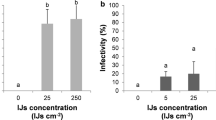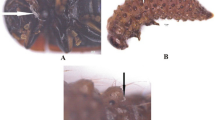Abstract
The efficacy of soil treatments of three native entomopathogenic nematodes (Steinernema carpocapsae, S. feltiae and Heterorhabditis bacteriophora) against Tuta absoluta larvae, pupae and adults was determined under laboratory conditions. The effect of three insecticides commonly used against T. absoluta, in the survival, infectivity and reproduction of these nematode strains was also evaluated. When dropped into soil to pupate, soil application of nematodes resulted in a high mortality of larvae: 100, 52.3 and 96.7 % efficacy for S. carpocapsae, S. feltiae and H. bacteriophora respectively. No mortality of pupae was observed and mortality of adults emerging from soil was 79.1 % for S. carpocapsae and 0.5 % for S. feltiae. The insecticides tested had a negligible effect on nematode survival, infectivity and reproduction. No sublethal effects were observed. Infective juveniles that survived to insecticide exposition were able to infect Galleria larvae with no significant differences from the control. The Galleria larvae affected by the three insecticides tested served as suitable hosts for the infection and reproduction of the nematodes. These results suggest that larvae of T. absoluta, falling from leaves following insecticide application, could be suitable hosts for nematodes, thereby increasing their concentration and persistence in the soil.





Similar content being viewed by others
References
Abbott WS (1925) A method of computing effectiveness of an insecticide. J Econ Entomol 18:265–267
Alumai A, Grewal PS (2004) Tank-mix compatibility of the entomopathogenic nematodes, Heterorhabditis bacteriophora and Steinernema carpocapsae, with selected chemical pesticides used in turfgrass. Biocontrol Sci Technol 14:725–730
Arnó J, Sorribas R, Prat M, Matas M, Pozo C, Rodriguez D, Garreta A, Gómez A, Gabarra R (2009) Tuta absoluta, a new pest in IPM tomatoes in the northeast of Spain. IOBC/WPRS Bull 49:203–208
Barrientos ZR, Apasblaza HJ, Norero SA, Estay PP (1998) Temperatura base y constante térmica de desarrollo de la polilla del tomate, Tuta absoluta (Lepidoptera: Gelechiidae). Cienc Invest Agraria 25:133–137
Batalla-Carrera L, Morton A, García-del-Pino F (2010) Efficacy of entomopathogenic nematodes against the tomato leafminer Tuta absoluta in laboratory and greenhouse conditions. BioControl 55:523–530
Begley JW (1990) Efficacy against insects in habitats others than soil. In: Gaugler R, Kaya HK (eds) Entomopathogenic nematodes in biological control. CRC Press, Boca Raton, FL, USA, pp 215–231
Bielza P (2010) La resistencia a insecticidas en Tuta absoluta. Phytoma 217:103–106
Boemare N (2002) Biology, taxonomy, and systematics of Photorhabdus and Xenorhabdus. In: Gaugler R (ed) Entomopathogenic nematology. CABI International, Wallingford, UK, pp 35–56
Cagnolo SR, Peschiutta ML, Bertolotti MA (2011) Susceptibility of adults of Anticarsia gemmatalis Hübner, 1818 (Lepidoptera: Noctuidae) to the entomopathogenic nematode Steinernema rarum (Doucet, 1986) Mamiya, 1988 (Rhabditida: Steinernematidae) under laboratory conditions. Nematology 13:373–376
Conover WK (1980) Practical nonparametric statistics. Wiley, New York, USA
Desneux N, Wajnberg E, Wyckhuys KAG, Burgio G, Arpaia S, Narváez-Vásquez CA, González-Cabrera J, Ruescas DC, Tabone E, Frandon J, Pizzol J, Poncet C, Cabello T, Urbaneja A (2010) Biological invasion of European tomato crops by Tuta absoluta: ecology, history of invasion and prospects for biological control. J Pest Sci 83:197–215
European and Mediterranean Plant Protection Organization (EPPO) (2010) Archives of the EPPO Reporting Service. http://archives.eppo.org/EPPO/Reporting/Reporting_Archives.htm. Accessed 1 Aug 2012
García-del-Pino F, Jové M (2005) Compatibility of entomopathogenic nematodes with fipronil. J Helminthol 79:333–337
García-del-Pino F, Morton A (2010) Synergistic effect of the herbicides glyphosate and MCPA on survival of entomopathogenic nematodes. Biocontrol Sci Technol 20:483–488
González-Cabrera J, Mollá O, Montón H, Urbaneja A (2011) Efficacy of Bacillus thuringiensis (Berliner) in controlling the tomato borer, Tuta absoluta (Meyrick) (Lepidoptera: Gellechiidae). BioControl 56:71–80
Grewal PS, Ehlers RU, Shapiro-Ilan DI (2005) Nematodes as biocontrol agents. CABI, New York, USA
Griffin CT (2012) Perspectives on the behaviour of entomopathogenic nematodes from dispersal to reproduction: traits contributing to nematode fitness and biocontrol efficacy. J Nematol 44:177–184
Hara AH, Kaya K (1982) Effects of selected insecticides and nematicides on the in vivo development of the entomogenous nematode Neoaplectana carpocapsae. J Nematol 14:486–491
Hara AH, Kaya HK (1983) Development of the entomogenous nematode, Neoaplectana carpocapsae (Rhabditida: Steinernematidae), in insecticide killed beet armyworm (Lepidoptera: Noctuidae). J Econ Entomol 76:423–426
Heungens A, Buysse G (1987) Toxicity of several pesticides in water solution on Heterorhabditis nematodes. Meded Fac Landbouww Rijksuniv Gent 52:631–638
Kaya HK, Grieve BJ (1982) The nematode Neoaplectana carpocapsae and the beet armyworm Spodoptera exigua: Infectivity of prepupae and pupae in soil and of adults during emergence from soil. J Invertebr Pathol 39:192–197
Kaya HK, Stock SP (1997) Techniques in insect nematology. In: Lacey LA (ed) Manual of techniques in insect pathology. Academic Press, San Diego, CA, USA, pp 281–324
Klein MG (1990) Efficacy against soil-inhabiting insect pests. In: Gaugler R, Kaya HK (eds) Entomopathogenic nematodes biological control. CRC Press, Boca Raton, FL, USA, pp 195–214
Koppenhöfer AM, Grewal PS (2005) Compatibility and interactions with agrochemicals and other biocontrol agents. In: Grewal PS, Ehlers RU, Shapiro-Ilan DI (eds) Nematodes as biocontrol agents. CABI Publishing, Wallingford, UK, pp 363–381
Koppenhöfer AM, Cowles RS, Cowles EA, Fuzy EM, Kaya HK (2003) Effect of neonicotinoid synergists on entomopathogenic nematode fitness. Entomol Exp Appl 106:7–18
Mbata GN, Shapiro DI (2005) Laboratory evaluation of virulence of Heterorhabditid nematodes to Plodia interpunctella Hübner (Lepidoptera: Pyralidae). Environ Entomol 34:676–682
Miranda MMM, Picanco M, Zanuncio JC, Guedes RNC (1998) Ecological life table of Tuta absoluta (Meyrick) (Lepidoptera: Gelechiidae). Biocontrol Sci Technol 8:597–606
Mollá O, Montón H, Vaqnaclocha P, Beitia F, Urbaneja A (2009) Predation by the mirids Nesidiocoris tenuis and Macrolophus pygmaeus on the tomato borer Tuta absoluta. IOBC/WPRS Bull 49:209–214
Morton A, García-del-Pino F (2009) Virulence of entomopathogenic nematodes to different stages of the flatheaded root borer, Capnodis tenebrionis (L.) (Coleoptera: Buprestidae). Nematology 3:365–373
Negrisoli AS, Garcia MS, Negrisoli CRCB (2010) Compatibility of entomopathogenic nematodes (Nematoda: Rhabditida) with registered insecticides for Spodoptera frugiperda (Smith, 1797) (Lepidoptera: Noctuidae) under laboratory conditions. Crop Prot 29:545–549
Poinar JRGO (1990) Biology and taxonomy of Steinernematidae and Heterorhabditidae. In: Gaugler R, Kaya HK (eds) Entomopathogenic nematodes in biological control. CRC Press, Boca Raton, FL, USA, pp 23–61
Půză V, Mrácěk Z (2010) Does scavenging extend the host range of entomopathogenic nematodes (Nematoda: Steinernematidae)? J Invertebr Pathol 104:1–3
Rovesti L, Deseö KV (1990) Compatibility of chemical pesticides with the entomopathogenic nematodes, Steinernema carpocapsae Weiser and S. feltiae Filipjev (Nematoda: Steinernematidae). Nematologica 36:237–245
Rovesti L, Heinzpeter EW, Tagliente F, Deseö KV (1988) Compatibility of pesticides with the entomopathogenic nematode Heterorhabditis bacteriophora Poinar (Nematoda: Heterorhabditidae). Nematologica 34:462–476
San-Blas E, Gowen SR (2008) Facultative scavenging as a survival strategy of entomopathogenic nematodes. Int J Parasitol 38:85–91
Shapiro-Ilan DI (2001a) Virulence of entomopathogenic nematodes to pecan weevil larvae, Curculio caryae (Coleoptera: Curculionidae), in the laboratory. J Econ Entomol 94:7–13
Shapiro-Ilan DI (2001b) Virulence of entomopathogenic nematodes to pecan weevil Curculio caryae (Coleoptera: Curculionidae) adults. J Econ Entomol 36:325–328
Triggliani O, Poinar GO Jr (1976) Infection of adult Lepidoptera by Neoaplectana carpocapsae (Nematoda). J Invertebr Pathol 27:413–414
Uchôa-Fernandes MA, Della Lucia TMC, Vilela EF (1995) Mating, oviposition and pupation of Scrobipalpula absoluta (Meyrick) (Lepidoptera: Gelechiidae). Anais da Sociedade Entomologica do Brasil 24:159–164
Urbaneja A, Vercher R, Navarro V, Porcuna JL, García María F (2007) La polilla del tomate, Tuta absoluta. Phytoma 194:16–23
Urbaneja A, Montón H, Mollá O (2009) Suitability of the tomato borer Tuta absoluta as prey for Macrolophus pygmaeus and Nesidiocoris tenuis. J Appl Entomol 133:292–296
Woodring JL, Kaya HK (1998) Steinernematid and Heterorhabditid nematodes: a handbook of techniques. South Co-op Bull 331:1–30
Acknowledgments
We thank Servei de Sanitat Vegetal (Generalitat de Catalunya) and Montse Martí (ADV Alt Maresme) for technical assistance to collect the tomato leafminer larvae and Mark Burch for language revision of the manuscript. This research was supported in part through Spanish Instituto Nacional de Investigación y Tecnologia Agraria projects (INIA-CC09-048).
Author information
Authors and Affiliations
Corresponding author
Additional information
Handling Editor: Ralf Ehlers.
Rights and permissions
About this article
Cite this article
Garcia-del-Pino, F., Alabern, X. & Morton, A. Efficacy of soil treatments of entomopathogenic nematodes against the larvae, pupae and adults of Tuta absoluta and their interaction with the insecticides used against this insect. BioControl 58, 723–731 (2013). https://doi.org/10.1007/s10526-013-9525-z
Received:
Accepted:
Published:
Issue Date:
DOI: https://doi.org/10.1007/s10526-013-9525-z




